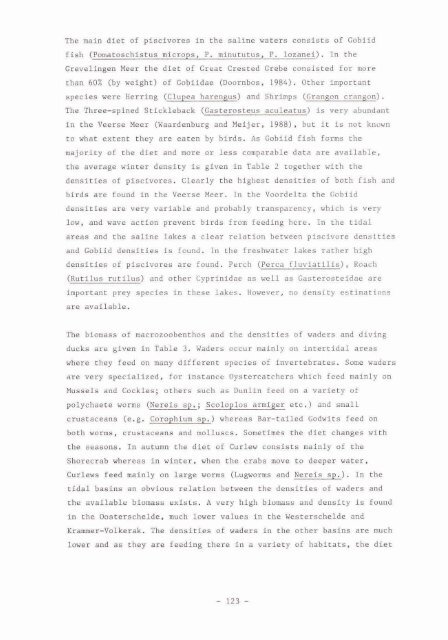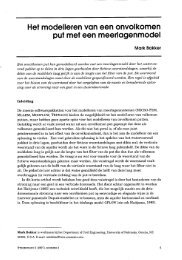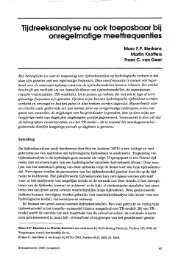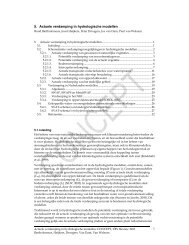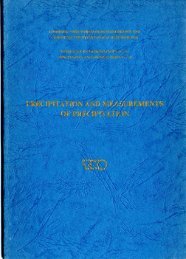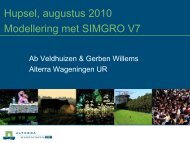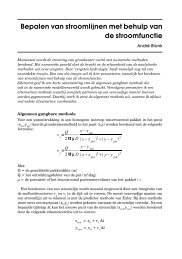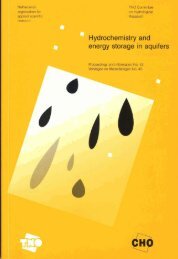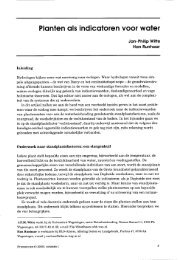Hydro-ecological relations in the Delta Waters
Hydro-ecological relations in the Delta Waters
Hydro-ecological relations in the Delta Waters
You also want an ePaper? Increase the reach of your titles
YUMPU automatically turns print PDFs into web optimized ePapers that Google loves.
The me<strong>in</strong> diet of piscivores <strong>in</strong> <strong>the</strong> salbe waters consists of Cobiid<br />
fish (Pomatosehistus microps, P. m<strong>in</strong>utums, P. loaanei). In <strong>the</strong><br />
Grevel<strong>in</strong>gen Meer <strong>the</strong> diet of Great Crested Grebe consisted for more<br />
<strong>the</strong>n 60%: (by weight) of Gobiidae (Domrnbos, 19$4). O<strong>the</strong>r important<br />
species were Herr<strong>in</strong>g (C1,u~eq harengus) and Shrimps (Grangmn crangon) .<br />
The Three-sp<strong>in</strong>od Stifkleback (6asterosteus aculeatus) is very abundant<br />
<strong>in</strong> <strong>the</strong> Veerse Meer (Waardenburg and Meiler, 19881, but it is not known<br />
ta &€it esent <strong>the</strong>y $re eaten by birds. As GmbFid fish fenus <strong>the</strong><br />
majority of <strong>the</strong> diet and more PT less comparable data are available,<br />
<strong>the</strong> average w<strong>in</strong>ter density is even h Table 2 toge<strong>the</strong>r with tha<br />
densities of pibcivofes. Clearly <strong>the</strong> highest densitieg of bath fish sad<br />
birds are found ib <strong>the</strong> Veerse Meer. In <strong>the</strong> Voordelta <strong>the</strong> nobiid<br />
densities ate varg varia%lo and prehably transparency. wMth is very<br />
low, end wave action prevent Birds from feed<strong>in</strong>g here. In <strong>the</strong> tidal<br />
areas and <strong>the</strong> sal<strong>in</strong>e lakes a clear relation bstwesn ptscivore densities<br />
and Gobffd densities is found. In <strong>the</strong> froshwatar lake6 ratber high<br />
densities of piscivores are found. Perch (Perca fluviatilis), Boaeh<br />
(Rutilus ~tilus) and o<strong>the</strong>r Cypr<strong>in</strong>idae as well as Gasterosteidae ere<br />
<strong>in</strong>portant prey species <strong>in</strong> <strong>the</strong>se lakes. Howevr;~, no density eqtimations<br />
are available.<br />
The bibmass of macrozoobenthos end <strong>the</strong> dessities of waders and div<strong>in</strong>g<br />
ducks ere given <strong>in</strong> Table 3. Waders occur -My on <strong>in</strong>tertidal areas<br />
here <strong>the</strong>y feed on *any dzffetent species @f izverteh~afes. Same waders<br />
are very speciUred, for <strong>in</strong>stance Cystercatchers which feed mditrly 6zl<br />
Mussels and Cackles; o<strong>the</strong>rs suCh as Dunl<strong>in</strong> feed on a verierp of<br />
polychaete worms (Rerefs sp.; Scoloplos armfger =Cc.) and small<br />
crustaceans (e.g. Corophiua sp.) whereas Bar-tailed Godwits feed on<br />
both worms, crustaceans and molluscs. Sometimes <strong>the</strong> diet ohansea with<br />
<strong>the</strong> seasons. In autumn <strong>the</strong> diet of Curlew oonaists ma<strong>in</strong>ly of <strong>the</strong><br />
Sharecrab wbereas <strong>in</strong> w<strong>in</strong>ter, when <strong>the</strong> crabs move to deeper water,<br />
Curlews feed l~ii<strong>in</strong>ly on large worms (Lugwonus and Nereis sp.). In <strong>the</strong><br />
tidal bas<strong>in</strong>s an obvious relation between <strong>the</strong> densities of waders and<br />
<strong>the</strong> available biomass extsts. A very high bkmass and density is fomd<br />
fn <strong>the</strong> Ooeteyschelde, much lower valnes <strong>in</strong> <strong>the</strong> Westerschelde and<br />
Kramer-Volkerak. The densities of waders <strong>in</strong> <strong>the</strong> o<strong>the</strong>r bas<strong>in</strong>s are much<br />
lmer and as <strong>the</strong>y arzt i?ee-g <strong>the</strong>se <strong>in</strong> a veriety of habitats, <strong>the</strong> diet


